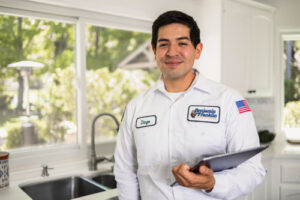Why is My Faucet Dripping When I Turn it Off?
 Is your faucet dripping and driving you crazy with that constant drip-drip-drip? Well, you’re not alone. It’s tempting to just ignore it, but trust me, that little leak can lead to bigger headaches down the road. Let’s chat about why your faucet might be misbehaving and what you can do about it.
Is your faucet dripping and driving you crazy with that constant drip-drip-drip? Well, you’re not alone. It’s tempting to just ignore it, but trust me, that little leak can lead to bigger headaches down the road. Let’s chat about why your faucet might be misbehaving and what you can do about it.
First things first, why should you care about a tiny drip? Well, aside from the annoying sound, it can jack up your water bill and even cause some serious plumbing issues if you let it go too long. So, let’s roll up our sleeves and figure out what’s going on.
Common Causes of a Leaky Faucet
Now, there are a bunch of reasons why your faucet might be leaking. Most of the time, it’s because some small part inside has worn out. You’ve got these little things called O-rings, washers, and gaskets that help keep everything watertight. Over time, they can get worn, break down, and start letting water sneak through.
O-rings, for instance, are small rubber rings that create seals in different parts of the faucet. When they wear out or become damaged, water can start leaking, causing that dreaded drip. Washers, typically made of rubber or metal, are another common culprit. They help seal the flow of water, but when they wear out, water can seep through the spout. Gaskets, which seal the faucet to the sink, can also fail, leading to leaks at the base.
Corrosion and mineral deposits from hard water can speed up the wear and tear on these parts, making the problem worse.
Troubleshooting a Leaky Faucet
So, how do you fix it? Well, it depends on where the leak is coming from. Is it dripping from the spout? Or maybe it’s seeping around the handle? Once you’ve pinpointed the culprit, you can start playing detective.
Issues with O-Rings
Let’s talk about O-rings for a sec. These little rubber rings might seem insignificant, but they’re actually super important for keeping your faucet leak-free. If one of these guys wears out, you’ll probably notice water dribbling out around the spout or handle.
The good news? Replacing an O-ring isn’t rocket science. You’ll need to turn off the water (always a good first step!), take apart the faucet, swap out the old O-ring for a new one, and put everything back together. Voila! No more drip.
If your faucet shows severe pitting or other damage, it might be time to consider replacing the entire faucet instead of just the O-ring.
Corroded Valve Seat
But what if it’s not the O-ring? Well, it could be a corroded valve seat. This is the part that connects your faucet to the spout. If it gets all gunked up with mineral deposits, water can start sneaking through. Constant exposure to water and minerals can cause the valve seat to corrode, creating gaps or rough spots where water can seep through, leading to leaks. Sometimes you can clean it up, but if it’s really bad, you might need to replace it.
Loose or Damaged Washer
Another common troublemaker is a loose or damaged washer. These little guys help create a tight seal when you turn off the faucet. If one gets wonky, you’ll notice water dripping from the spout even though your faucet is turned off. Replacing a washer is usually pretty straightforward – just make sure you get the right size!
In some newer faucets, especially those with plastic valve cartridges, the washers and seats can wear out more quickly. If you’re dealing with a plastic valve, you might need to replace the entire cartridge rather than just the washer.
Leaking Disc Cartridge Faucets
Now, if you’ve got a fancy disc cartridge faucet, the problem might be with the cartridge itself. These faucets are usually pretty reliable, but nothing lasts forever. In disc cartridge faucets, the inlet and outlet seals can wear out or become clogged with sediment, leading to leaks. If the seals wear out or get clogged with gunk, you might start seeing leaks.
Regular maintenance can go a long way in preventing leaks in disc cartridge faucets. This includes cleaning out any sediment that might have accumulated and replacing worn seals. If the cartridge itself is damaged, though, you might need to replace it entirely.
When to Call a Professional
Here’s the thing: if you’ve tried everything and the faucet is still leaking, it might be time to call in the pros at Benjamin Franklin Plumbing. Sometimes the problem is more complicated than it looks, and you don’t want to risk making things worse.
And hey, if your faucet is getting up there in years, it might just be time for an upgrade. When you’re shopping for a new faucet, think about things like style (because who doesn’t want a good-looking faucet?), how it works, and how efficient it is with water use.
Bottom line? Don’t let that dripping faucet drive you up the wall. Take a look, see if you can fix it yourself, and if not, don’t be shy about calling Fort Meyers’ punctual plumber. Your sanity (and your water bill) will thank you!
 Water heating systems are easy to ignore until they develop symptoms. An ailing unit should receive immediate attention. A broken unit can cause indoor flooding and damage your home. Leaks are a common symptom, but there are others.
Water heating systems are easy to ignore until they develop symptoms. An ailing unit should receive immediate attention. A broken unit can cause indoor flooding and damage your home. Leaks are a common symptom, but there are others. If you’re in the market for a new water heater, you may be wondering how tank and tankless models compare. We’ll discuss the two types of heaters so you can discover which might be best for you.
If you’re in the market for a new water heater, you may be wondering how tank and tankless models compare. We’ll discuss the two types of heaters so you can discover which might be best for you.
 If not properly maintained, a water heater has the potential to explode, which renders it inoperable. It will also likely cause structural damage to your home and may also cause bodily injury if you are located too close to the water heater when an explosion occurs. Fortunately, there are signs that an explosion might be imminent, which allows you to take action before such a terrifying event can occur.
If not properly maintained, a water heater has the potential to explode, which renders it inoperable. It will also likely cause structural damage to your home and may also cause bodily injury if you are located too close to the water heater when an explosion occurs. Fortunately, there are signs that an explosion might be imminent, which allows you to take action before such a terrifying event can occur.
 Two of the most common types of pipes used for plumbing are PEX and copper. In some applications, they can be used interchangeably, but there are many differences between the two. Let’s take a look at some of these, and then you can decide which one will work best for you.
Two of the most common types of pipes used for plumbing are PEX and copper. In some applications, they can be used interchangeably, but there are many differences between the two. Let’s take a look at some of these, and then you can decide which one will work best for you.